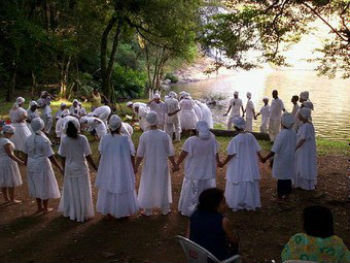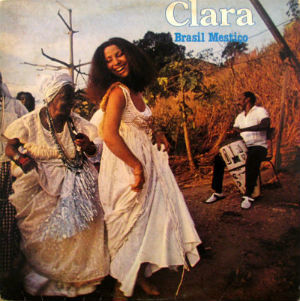The Umbanda is a monotheistic religion and african-Brazilian, which appeared in 1908, founded by Zélio Fernandina de Moraes.
The word “umbanda” belongs to the Quimbundo vocabulary of Angola and means “art of healing”.
Umbanda Origin
Umbanda is a religion that emerged in the suburbs of Rio de Janeiro.
On November 15, 1908, Zélio Fernandino de Moraes, born in São Gonçalo / RJ, was incorporated from the Caboclo das Sete Encruzilhadas. This spirit would have helped him to create the Umbanda religion.
Quickly, it spread throughout Brazil and other Latin American countries.
Their beliefs mix elements of candomblé, spiritism and catholicism. Therefore, for many scholars, Umbanda would be only the animal-free candomblé that would be most accepted by the urban white population.
He also took concepts of kardecism, which was coming to the country, such as “evolution” and “reincarnation”.
He also has Jesus as a spiritual reference and it is not uncommon to find his image in a prominent place on the altars of Umbanda houses or terraces.
Umbanda Place of Worship
Umbanda celebration held on the edge of a pond
The place for the umbanda ceremonies is called Casa, Terreiro or Barracão. Also, various celebrations are held outdoors, with nature, in rivers, waterfalls or on the beach.
These ceremonies are presided over by a “father” or “mother,” a priest who directs the rites and runs the house. He is also responsible for teaching the Umbanda doctrine and secrets to his disciples.
Umbanda Ceremonies
In these places “pass” sessions are held, in which the entity reorganizes the person’s “astral energy field”.
Likewise, “discharge” sessions are held when the negative energy of the person is captured and transferred to the temple grounds.
Note that no remuneration is allowed for these spiritual works.
The most commonly worn garments in these ceremonies are white because it is the neutral color that pleases all orixás and guides.
In Umbanda there is no animal sacrifice and rituals of baptism, consecration and marriage are celebrated.
Umbanda Points
Umbanda points are songs to praise, call and say goodbye to the orixá and the lines of entities.
Accompanied by percussion instruments such as the atabaque, it is important to know the rhythm of each orisha / entity. This learning begins in the initiate’s childhood. Equally you need to know a multitude of songs.
Umbanda and candomblé points directly influenced Brazilian popular music.
Umbanda Anthem
Although Umbanda varies according to each region of Brazil and each house / yard, at least one song is very popular: the Umbanda Anthem.
Composed by José Manoel Alves (lyrics) and Dalmo da Trindade Reis (music) was made official as anthem in 1961.
Reflected the Divine Light
With all its splendor
It is from the kingdom of Oxalá
Where there is peace and love
Light that reflected on the earth
Light that reflected on the sea
Light that came from Aruanda
For all to illuminate
Umbanda is peace and love
It’s a world full of light
It’s the force that gives us life
It’s the greatness that drives us
Onwards, children of faith
Like our law there
Leading to the whole world
The flag of Oxalá
Carrying the whole world the
Oxalá flag
Umbanda Symbols
Before commencing ceremonies in Umbanda it is common for a person initiated to scratch the ground with various symbols: stars, crosses, tridents, straight or curved strokes, etc.
These may vary by Umbanda house, but the meaning is the same. That is, to call the entities to be worked on, to ensure the arrival of the guides to be incorporated, to honor the orishas, to bring good fluids and energies to the participants.
Umbanda Beliefs
Like all polytheistic religions, Umbanda worships not a single god, but various personifications of elements of nature and energy called orishas.
However, in Umbanda, there is the concept of a supreme God, called “ Olorum” or “Oxalá” . They believe in the immortality of the soul, reincarnation and karmic laws.
They believe in orishas and spirit guides. These can be incorporated during certain ceremonies and come to earth to help those in need.
The guides are called “entities” and each orisha has a line of entities that assists it.
Orixás and Entities of Umbanda
The orishas found in Umbanda are Oxalá, Xangô, Iemanjá, Ogum and Oxossi, Oxum, Iansã, Omulú and Nanã.
Here we list the main entities manifesting in Umbanda.
- Caboclos: They are Indian spirits who return to the earthly world to help people with health problems.
- Old Black: They are people who were brought from Africa to be slaves in Brazil. Although they suffered in life, they are now evolved spirits that give great advice to those who seek them.
- Baianos: People who lived in Bahia and chose to be guides and help those in need. They work with jobs, health, moral strength.
- Marines / Sailors: In some regions this line does not exist. They work with psychological, physical, spiritual cleansing, who know what they say, always speak the truth. They are always rocking because they come from the sea, they had a hard life, but a lot of learning.
- Eres: They are the spirits of children. Laughing and love to play. They comfort the afflicted, the fathers and mothers, and sometimes commit some mischief.
- Zé Pilintra: He was born in Pernambuco and went to Recife and had four brothers. He was orphaned by his father and mother and to survive he began to carry out small thefts and cheats. He came to Rio de Janeiro where he continued to frequent the environment of trickery and prostitutes. He cares for the addicted women, the mistreated, the prostitutes, the forgotten.
- Maria Padilha: In life was a luxury prostitute and pimp. Always portrayed as a sensual, well-dressed and seductive woman. A cute dove that helps women in depression, with their problems, lonely.
There are also other entities such as Cattle farmers, Gypsies, Orientals, etc.
To carry out the spiritual work, those responsible for the connection between the spiritual and material world, the mediums, will receive (incorporate) these entities and thus help the consultant.
Thus, we realize that Umbanda strikes a balance between syncretism and Afro-Brazilian religions.
Umbanda History
The singer Clara Nunes was one of the promoters of Umbanda in Brazil and worldwide.
Umbanda has long been confused with “carumba macumba” or “Quimbanda”. In 1905, João do Rio (1881-1921), publishes his reports that resulted in the book “The Religions of Rio” and mentions rites incorporating caboclos and old-black spirits.
Many terreiros were born from Kardecism, such as the “Our Lady of Piety Spiritist Tent” in 1908.
But later, between 1920 and 1930, the repression of African religions led to the union of several houses and terraces.
It was necessary to organize and standardize Umbanda worship, standardizing some doctrinal guidelines to avoid persecution.
It was common at that time to use the term “spiritist” as a way to avoid persecution of the new Afro-Brazilian religions.
However, to legitimize itself, Umbanda sought to “de- Africanise ” and whiten. To this end, in 1939, the first Umbanda Federation, the Umbanda Spiritist Union of Brazil (UEUB), arose when the origin of Umbanda was established in the East or East Africa.
On the other hand, in the context of the Military Dictatorship (1964-1985), Umbanda will serve as an instrument of legitimation for the nationalist project. Thus religion makes headlines in newspapers and magazines.
Finally, during the 1980s, with the rise of the neo-Pentecostal churches, African-based religions were once again under attack by some believers.
Currently, Law 11,635 of December 27, 2007, makes this the “National Day to Combat Religious Prejudice” and now protects the religions of African mothers.



